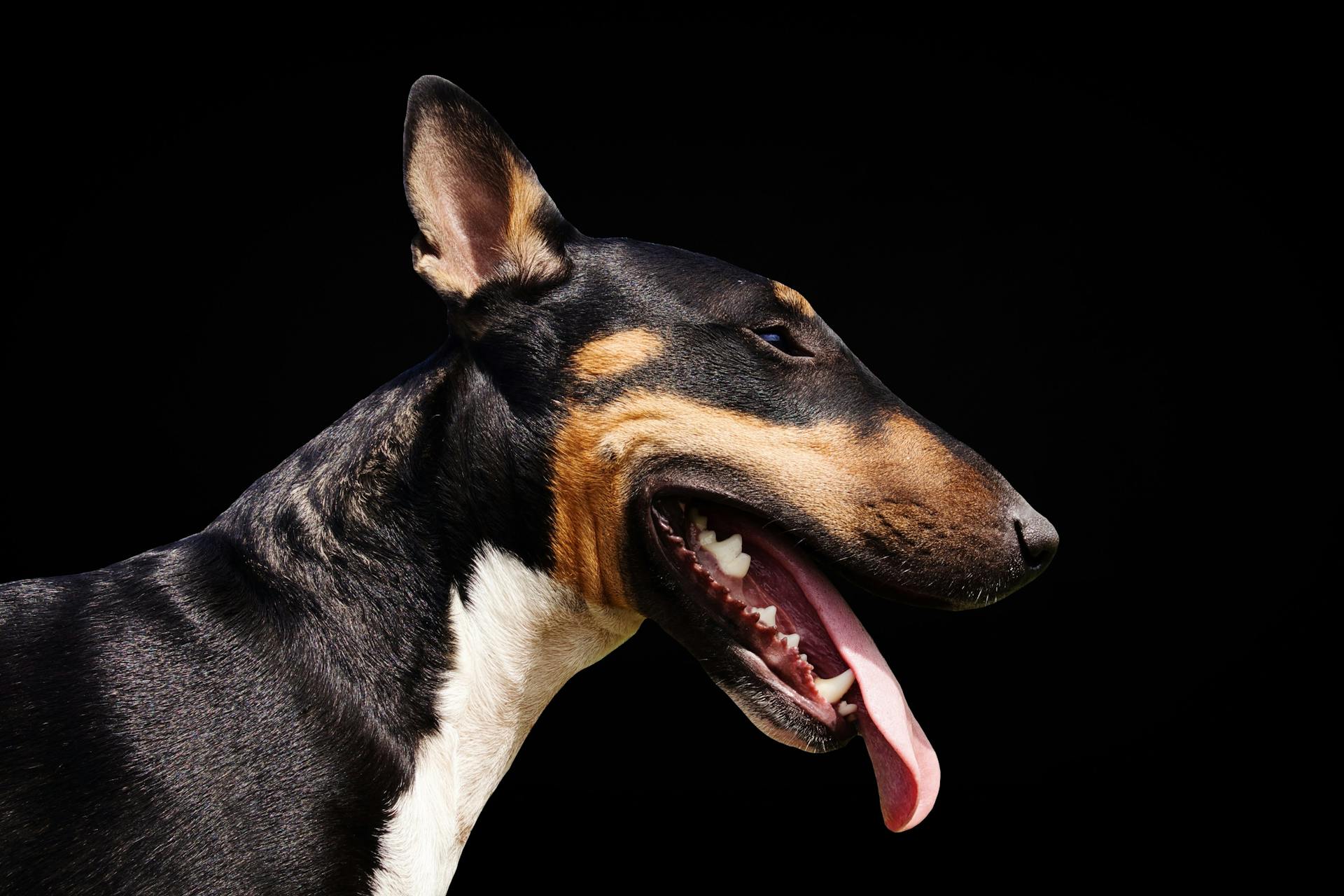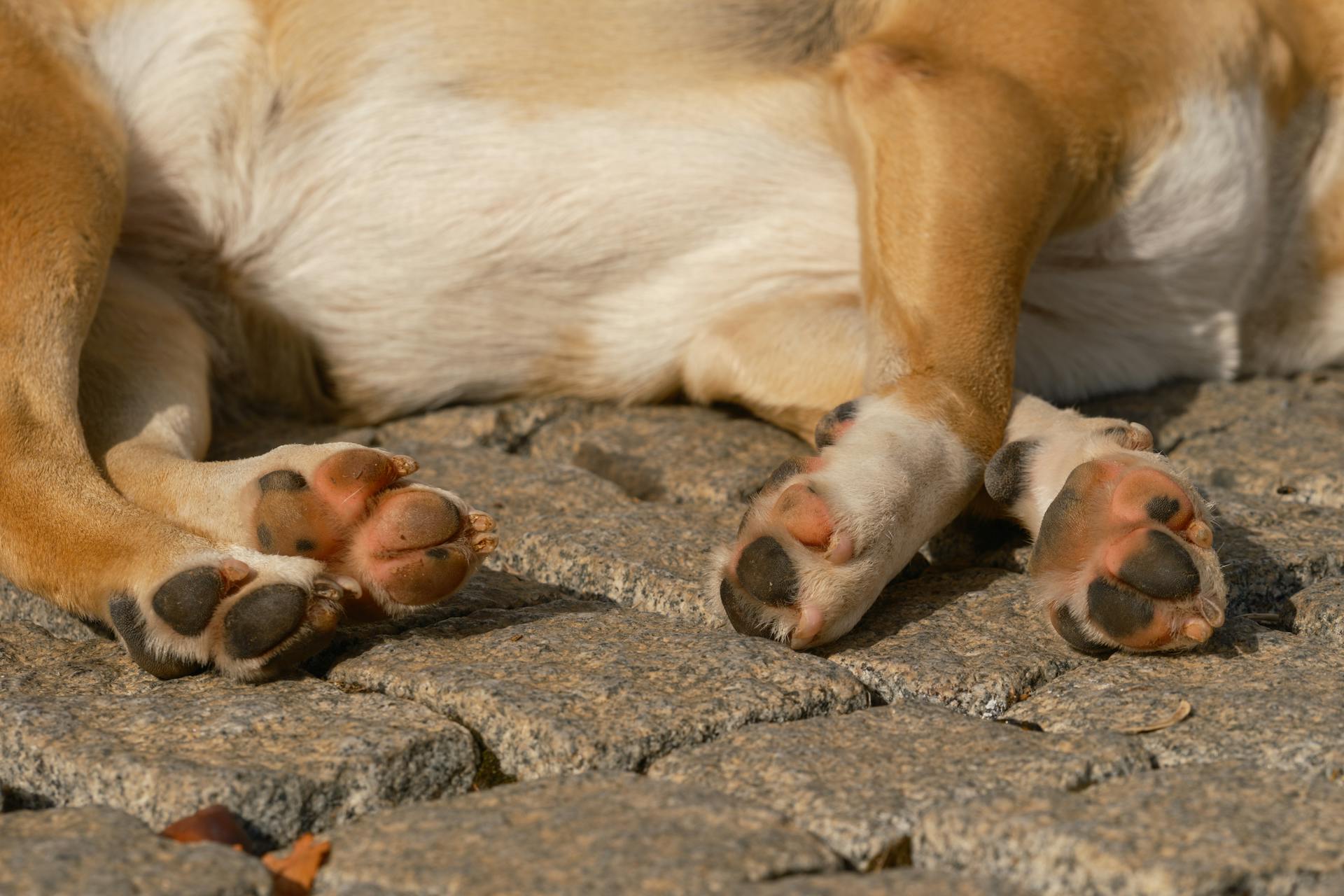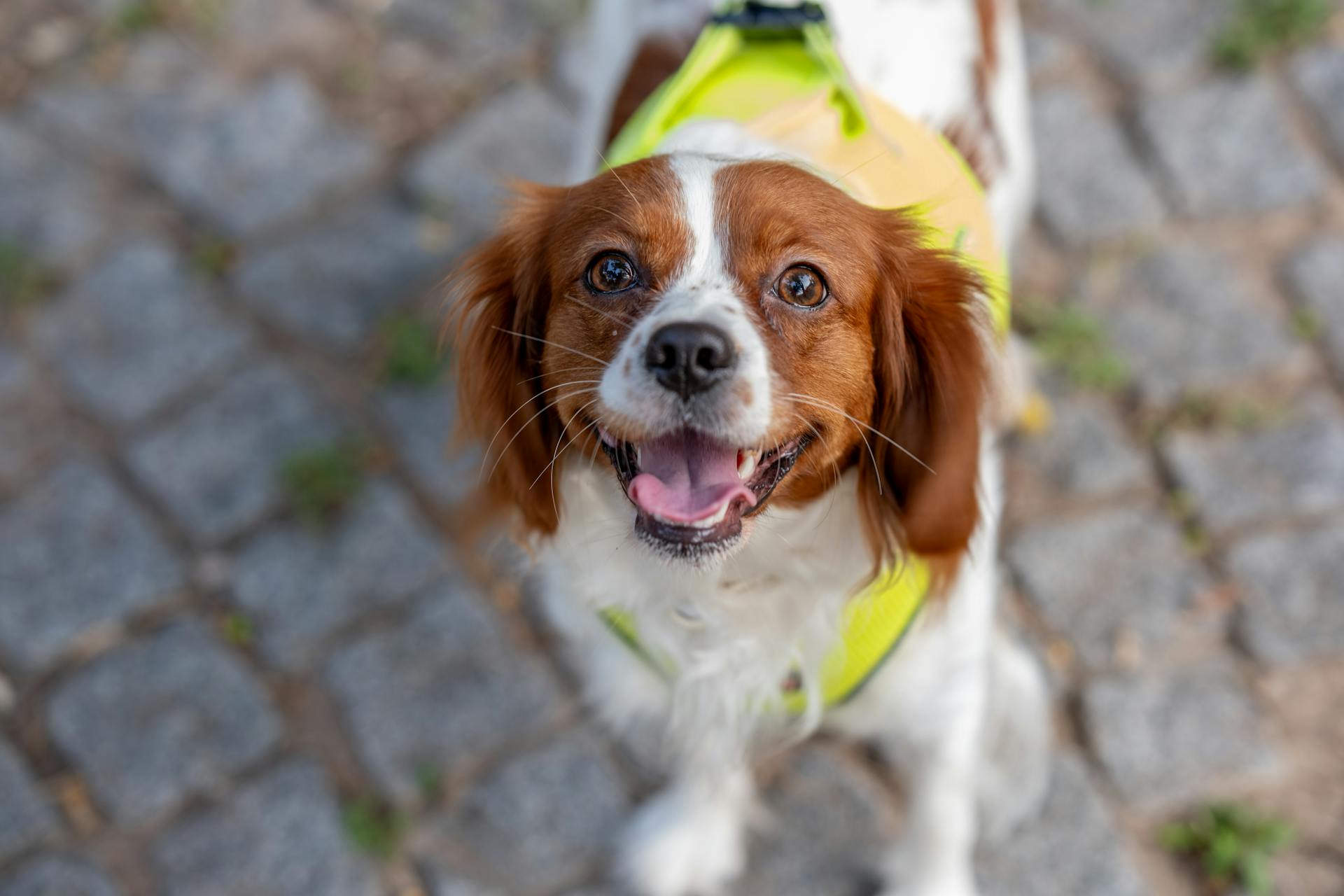
The canine sinus anatomy is a complex system that plays a crucial role in maintaining your dog's overall health. The nasal passages, frontal sinuses, and maxillary sinuses are all connected and work together to filter the air your dog breathes.
Each sinus has a unique shape and size, with the frontal sinuses being the largest and most prominent. The maxillary sinuses are located in the dog's cheekbones and are responsible for producing mucus that helps to trap dust and other particles.
The nasal passages are the first line of defense against infection and disease, with the cilia and mucus working together to filter out debris and pathogens. The paranasal sinuses, including the frontal, maxillary, and sphenoid sinuses, help to humidify and warm the air your dog breathes.
Explore further: Maxillary Canine Anatomy
Canine Sinus Anatomy Basics
The canine sinus anatomy is made up of several key structures. The frontal sinuses are located in the forehead, just beneath the eyes.
The frontal sinuses are divided into two parts, the anterior and posterior sinuses, which are connected by a thin bony wall. The ethmoid sinuses, on the other hand, are a complex network of small air cells located between the nasal cavity and the eye socket.
The maxillary sinuses are the largest of the paranasal sinuses and are located in the cheekbones. The sphenoid sinuses are located in the sphenoid bone, near the base of the skull.
Sphenoid Bone
The sphenoid bone is a butterfly-shaped bone located in the skull, playing a crucial role in the canine sinus anatomy.
It forms the posterior part of the nasal cavity and separates the nasal passages from the cranial cavity.
Recommended read: Canine Nasal Cancer Symptoms
Nasal Conchae
The nasal conchae play a crucial role in a dog's respiratory and olfactory systems. They are turbinate bones that project into the nasal cavity to support the olfactory mucus membranes and increase the respiratory surface area.
Recommended read: Respiratory System of the Dog
These conchae are cartilage or ossified scrolls that arise from the ethmoid bone and are covered with mucous membrane. Underneath the mucous membrane lies a layer of anastomosing blood vessels.
The nasal conchae are more complex in animals with a better sense of smell, increasing the surface area of the olfactory region. In dogs, this is beneficial for their keen sense of smell.
The conchae divide the nasal cavity into nasal ducts or meatuses, which branch out from a common nasal meatus adjacent to the nasal septum. There are three nasal meatuses: dorsal, middle, and ventral.
The dorsal nasal meatus is the passage between the roof of the nasal cavity and the dorsal nasal concha. The middle nasal meatus is between the dorsal and ventral conchae and communicates with the paranasal sinuses.
The ventral nasal meatus is the main pathway for airflow leading to the pharynx, positioned between the ventral nasal concha and the floor of the nasal cavity. The common nasal meatus is the longitudinal space on either side of the nasal septum.
Dog Anatomy
A dog's nose is an incredible sensory organ, and understanding its anatomy is key to appreciating its remarkable sense of smell. The nasal cavity is large, allowing for efficient breathing and scent detection.
The nostrils are the external openings of the nasal passages, where air and scent molecules enter the nose. The nasal planum, or "nose pad", is the smooth, leathery surface surrounding the nostrils.
The nasal vestibule is the initial portion of the nasal passages, lined with specialized hairs and mucus-producing glands that filter and humidify the air. The nasal septum is a thin cartilage and bone wall dividing the nasal cavity into left and right sides.
Here are the main parts of a dog's nose:
- Nostrils: The external openings of the nasal passages through which air and scent molecules enter the nose.
- Nasal Planum: The smooth, leathery surface surrounding the dog’s nostrils.
- Nasal Vestibule: The initial portion of the nasal passages is lined with specialized hairs and mucus-producing glands that filter and humidify the air.
- Nasal Cavity: The hollow space behind the nostrils where airflow is directed, lined with mucous membranes that further filter and humidify the air.
- Nasal Septum: A thin cartilage and bone wall dividing the nasal cavity into left and right sides.
- Turbinates: Bony structures covered in mucous membranes that protrude into the nasal cavity, increasing its surface area.
- Olfactory Epithelium: A specialized tissue in the nasal cavity containing millions of olfactory receptor cells.
What is a Dog?
Dogs are incredibly unique creatures, and their anatomy plays a huge role in their exceptional abilities.
Dogs have a network of approximately 220 million olfactory receptors in their noses, which is 40 times superior to humans.
This exceptional sense of smell allows them to detect the faintest odors and differentiate between various scents.
Dogs' sense of smell is invaluable in search and rescue, detection work, and hunting.
Their nose anatomy enables them to effectively search for human remains and cadavers, contributing to the closure of cases.
How Does the Dog Work?
The dog's nose is a remarkable sensory organ that lets them process scents with remarkable precision.
Dogs have a unique nasal cavity shape that's crucial for their olfactory abilities, aiding in searching for lost people, detecting explosives, and signaling diseases.
Their nasal cavity is large, which allows for efficient breathing and scent detection. The presence of turbinates increases the surface area for detecting odors, making their sense of smell even more impressive.
Millions of receptor cells in the olfactory epithelium detect odor molecules, and the nasal passages trap scent particles, directing them towards the olfactory epithelium.
Broaden your view: Tail Gland Hyperplasia Female Dog
Turbinates
Turbinates are bony structures in the nasal cavity that filter, humidify, and warm the inhaled air.
They house numerous scent receptors that assist olfactory perception. These receptors are crucial for a dog's sense of smell and help them detect and differentiate various scents.
The turbinates are essential for optimizing air quality and regulating the dog's respiratory system. They moisten and warm the air before it reaches the lungs, preventing irritation and damage to the respiratory tissues.
Filtering out impurities ensures the air entering the dog's lungs is clean and free of harmful particles.
Here's a breakdown of the functions of the turbinates:
The turbinates are more complex in animals with a better sense of smell, as they increase the surface area of the olfactory region, further enhancing their ability to detect scents.
Dog Health Issues
Dogs can experience a range of nasal problems that affect their quality of life. One common issue is nasal discharge, which can be clear, mucoid, or even contain pus, indicating an infection or irritation.
Nasal congestion is another frequent problem, often caused by allergies, infections, or structural issues. I've seen it in dogs that have seasonal allergies, and it's quite uncomfortable for them.
Epistaxis, or nosebleeds, can occur due to various reasons such as trauma, nasal tumors, or infections. It's essential to seek veterinary care if you notice blood in your dog's nasal discharge.
Nasal tumors are a serious issue, leading to symptoms like nasal discharge, epistaxis, and breathing difficulties. These tumors can be life-threatening if left untreated.
Nasal polyps are non-cancerous growths that obstruct the nasal passages, causing breathing problems and discomfort. They can be challenging to diagnose, but a veterinarian can help identify them.
Nasal infections can be caused by bacteria, viruses, or fungi, and result in discharge, congestion, and sneezing. It's crucial to keep an eye out for these symptoms and seek veterinary care if they persist.
Here's a list of common nasal problems in dogs:
- Nasal Discharge
- Nasal Congestion
- Epistaxis
- Nasal Tumors
- Nasal Polyps
- Nasal Infections
- Nasal Trauma
- Nasal Foreign Bodies
- Nasal Deformities
- Nasal Allergies
Comparing Dog and Human Biology
Dogs have a more complex and efficient olfactory system than humans, allowing them to detect scents at low concentrations undetectable to humans.
Dogs possess more olfactory receptors than humans, which enables them to analyze a wide range of smells with ease.
Their larger olfactory epithelium surface area is also a key factor in their superior sense of smell.
Types of Dogs
Dogs come in a variety of shapes and sizes, and their noses are no exception. Some breeds have short, flattened faces and noses, like the Bulldog, Pug, and Boxer, which can lead to breathing difficulties.
These breeds are classified as having brachycephalic noses. Dolichocephalic breeds, on the other hand, have long, narrow skulls and elongated noses, which contribute to an enhanced sense of smell.
Dogs like the Greyhound, Afghan Hound, and Collie are great examples of this. Breeds with medium-sized heads and noses that lie between the extremes of brachycephalic and dolichocephalic are mesaticephalic.
You might enjoy: Breeds of Dogs with Rear Dew Claws
Labrador Retrievers, Golden Retrievers, and German Shepherds are popular breeds that fall into this category. Some breeds have short, slightly upturned noses, which can lead to breathing issues and require special care.
Dogs like the Boston Terrier, French Bulldog, and Shih Tzu are classified as having snub-nosed noses. Breeds with a distinctive convex curvature of the nasal bridge, like the Bloodhound, have Roman noses.
The shape of the nose varies in prominence within this category. Dogs with long, tapering snouts, like the German Shepherd, Collie, and Dachshund, have pointed noses.
These noses contribute to a keen sense of smell and are associated with dolichocephalic breeds. Some breeds have noses that are square-shaped, like the Boxer and the Bull Terrier.
Here's a breakdown of the different types of dog noses:
- Brachycephalic: short, flattened faces and noses
- Dolichocephalic: long, narrow skulls and elongated noses
- Mesaticephalic: medium-sized heads and noses between brachycephalic and dolichocephalic
- Snub-nosed: short, slightly upturned noses
- Roman-nosed: distinctive convex curvature of the nasal bridge
- Pointed: long, tapering snouts
- Square: square-shaped noses
Sources
- https://emedicine.medscape.com/article/1899145-overview
- https://www.merckvetmanual.com/respiratory-system/respiratory-diseases-of-small-animals/rhinitis-and-sinusitis-in-dogs-and-cats
- https://www.honestpaws.com/blogs/health/dog-nose-anatomy
- https://en.wikivet.net/Nasal_Cavity_-_Anatomy_%26_Physiology
- https://vanat.ahc.umn.edu/carnLabs/Lab25/Lab25.html
Featured Images: pexels.com


